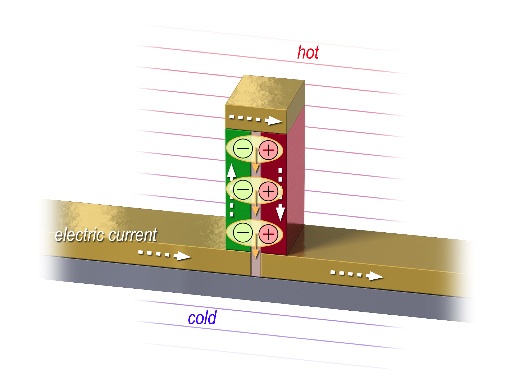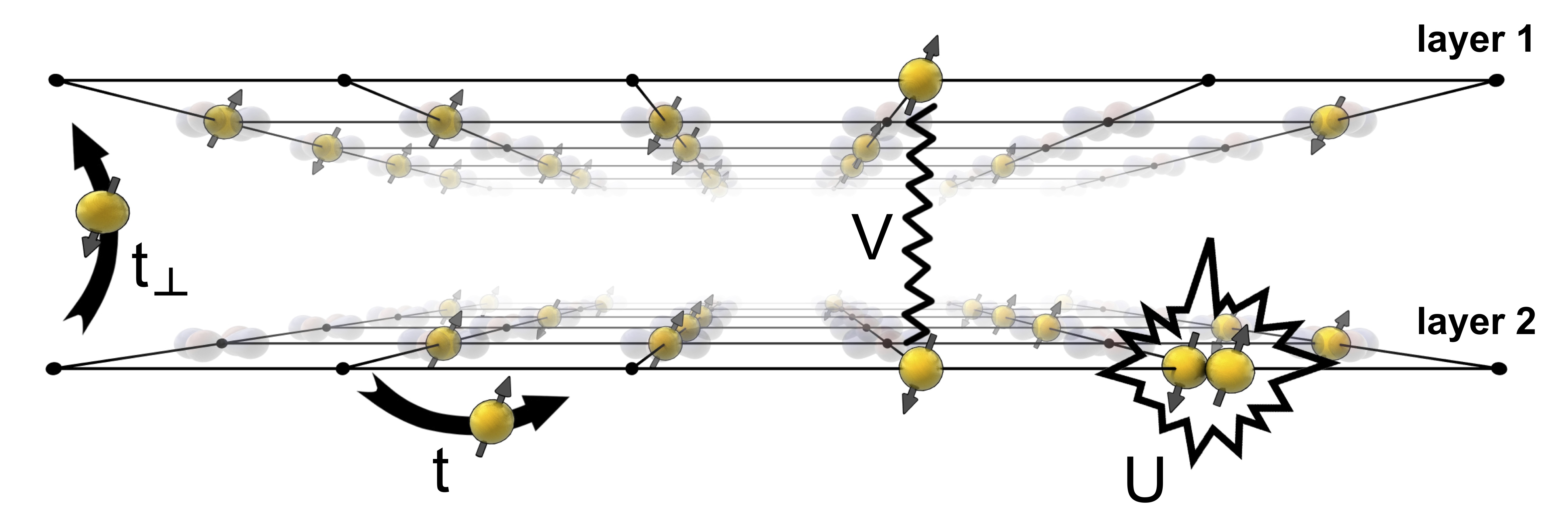Title: The Instability of a Quantum Superposition of Time Dilations
Abstract: Using the relativistic concept of time dilation we show that a superposition of gravitational potentials can lead to nonunitary time evolution. For sufficiently weak gravitational potentials one can still define, for all intents and purposes, a global coordinate system. A probe particle in a superposition of weak gravitational fields will, however, experience dephasing due to the different time dilations. The corresponding instability timescale is accessible to experiments, and can be used as a degree of macroscopicity. Finally, we suggest an experiment with smoothly tunable amplification in a microwave interferometer that allows a quantitative study of the quantum to classical boundary.
arXiv preprint: How bilayer excitons can greatly enhance thermoelectric efficiency
Title: How bilayer excitons can greatly enhance thermoelectric efficiency
Abstract: Currently, one of the major nanotechnological challenges is to design thermoelectric devices that have a high figure of merit. To that end, we propose to use bilayer excitons. Bilayer exciton systems are shown to have an improved thermopower and an enhanced electric counterflow and thermal conductivity, with respect to regular semiconductor-based thermoelectrics. Here we present a roadmap towards experimental realization of a bilayer exciton thermocouple. A bilayer exciton heterostructures of p- and n-doped Bi2Te3 can have a figure of merit zT∼60. Another material suggestion is to make a bilayer out of electron-doped SrTiO3 and hole-doped Ca3Co4O9.
Reference: Kai Wu, Louk Rademaker, Jan Zaanen; arXiv:1401.7770.
arXiv preprint: Exciton condensation in strongly correlated electron bilayers
Title: Exciton condensation in strongly correlated electron bilayers
Abstract:We studied the possibility of exciton condensation in Mott insulating bilayers. In these strongly correlated systems an exciton is the bound state of a double occupied and empty site. In the strong coupling limit the exciton acts as a hard-core boson. Its physics are captured by the exciton t-J model, containing an effective XXZ model describing the exciton dynamics only. Using numerical simulations and analytical mean field theory we constructed the ground state phase diagram. Three homogeneous phases can be distinguished: the antiferromagnet, the exciton checkerboard crystal and the exciton superfluid. For most model parameters, however, we predict macroscopic phase separation between these phases. The exciton superfluid exists only for large exciton hopping energy. Additionally we studied the collective modes and susceptibilities of the three phases. In the superfluid phase we find the striking feature that the bandwidth of the spin-triplet excitations, potentially detectable by resonant inelastic x-ray scattering (RIXS), is proportional to the superfluid density. The superfluid phase mode is visible in the charge susceptibility, measurable by RIXS or electron energy loss spectroscopy (EELS).
Reference: Louk Rademaker, Jeroen van den Brink, Jan Zaanen, Hans Hilgenkamp, arXiv:1310.0685
arXiv preprint: Determinant quantum Monte Carlo study of exciton condensation in the bilayer Hubbard model
Title: Determinant quantum Monte Carlo study of exciton condensation in the bilayer Hubbard model
Abstract: We studied the possibility of exciton condensation in a strongly correlated bilayer extended Hubbard model using Determinant Quantum Monte Carlo. To model both the onsite repulsion U and the interlayer interaction V we introduced a novel update scheme extending the standard Sherman-Morrison update. We observe that the sign problem increases dramatically with the inclusion of the interlayer interaction V, which prohibits at this stage a unequivocal conclusion regarding the presence of exciton condensation. However, enhancement of the interlayer tunneling results suggest that the strongest exciton condensation tendency lies around 10-20 % p/n-doping. Magnetic properties and conductivity turn out to be relatively independent of the interlayer interaction.
Reference: Louk Rademaker, Steve Johnston, Jan Zaanen, Jeroen van den Brink, arXiv:1310.0623
arXiv preprint: Influence of long-range interactions on charge ordering phenomena on a square lattice
Title: Influence of long-range interactions on charge ordering phenomena on a square lattice
Abstract: Usually complex charge ordering phenomena arise due to competing interactions. We have studied how such ordered patterns emerge from the frustration of a long-ranged interaction on a lattice. Using the lattice gas model on a square lattice with fixed particle density, we have identified several interesting phases; such as a generalization of Wigner crystals at low particle densities and stripe phases at densities in between rho = 1/3 and rho = 1/2. These stripes act as domain walls in the checkerboard phase present at half-filling. The phases are characterised at zero temperatures using numerical simulations, and mean field theory is used to construct a finite temperature phase diagram.
Reference: Louk Rademaker, Yohanes Pramudya, Jan Zaanen, Vladimir Dobrosavljevic, arXiv:1304.3643
arXiv preprint: Enhancement of spin propagation due to interlayer exciton condensation
Title: Enhancement of spin propagation due to interlayer exciton condensation
Abstract: We show that an interlayer exciton condensate doped into a strongly correlated Mott insulator exhibits a remarkable enhancement of the bandwidth of the magnetic excitations (triplons). This triplon is visible in the dynamical magnetic susceptibility and can be measured using resonant inelastic x-ray scattering. The bandwidth of the triplon scales with the exciton superfluid density, but only in the limit of strong correlations. As such the triplon bandwidth acts as a probe of exciton-spin interactions in the condensate.
Reference: Louk Rademaker, Jeroen van den Brink, Hans Hilgenkamp, Jan Zaanen, arXiv:1304.3643
arXiv preprint: Dynamics of a single exciton in strongly correlated bilayers
Title: Dynamics of a single exciton in strongly correlated bilayers
Abstract: We formulated an effective theory for a single interlayer exciton in a bilayer quantum antiferromagnet, in the limit that the holon and doublon are strongly bound onto one interlayer rung by the Coulomb force. Upon using a rung linear spin wave approximation of the bilayer Heisenberg model, we calculated the spectral function of the exciton for a wide range of the interlayer Heisenberg coupling \alpha=J_{\perp}/Jz. In the disordered phase at large \alpha, a coherent quasiparticle peak appears representing free motion of the exciton in a spin singlet background. In the N\'{e}el phase, which applies to more realistic model parameters, a ladder spectrum arises due to Ising confinement of the exciton. The exciton spectrum is visible in measurements of the dielectric function, such as c-axis optical conductivity measurements.
Reference: Louk Rademaker, Kai Wu and Jan Zaanen, arXiv:1202.3616
arXiv preprint: The dynamical frustration of interlayer excitons delocalizing in bilayer quantum antiferromagnets
Last week I put my work on exciton dynamics in strongly correlated bilayers onto the arXiv!
Title: The dynamical frustration of interlayer excitons delocalizing in bilayer quantum antiferromagnets
Abstract: Using the self-consistent Born approximation we study the delocalization of interlayer excitons in the bilayer Heisenberg quantum antiferromagnet (see figure above). Under realistic conditions we find that the coupling between the exciton motion and the spin system is strongly enhanced as compared to the case of a single carrier, to a degree that it mimics the confinement physics of carriers in Ising spin systems. We predict that the ‘ladder spectrum’ associated with this confinement physics should be visible in the c-axis exciton spectra of insulating bilayer cuprates such as YBa2Cu3O6. Our discovery indicates that finite density systems of such excitons should show very rich physical behavior.
Reference: Louk Rademaker, Kai Wu, Hans Hilgenkamp and Jan Zaanen, arXiv:1106.5347
arXiv preprint: Prediction of the quantization of magnetic flux in double layer exciton superfluids
I just posted a preprint paper on the arXiv, with the following abstract.
Currently a way is lacking to detect unambiguously the possible phase coherence of an exciton condensate in an electron-hole double layer. Here we show that despite the fact that excitons are charge-neutral, the double layer exciton superfluid exhibits a diamagnetic response. In devices with specific circular geometry the magnetic flux threading between the layers must be quantized in units of $latex \frac{h}{e} \chi_m$ where $latex \chi_m$ is the diamagnetic susceptibility of the device. We discuss possible experimental realizations of the predicted unconventional flux quantization.
See the whole article at arXiv:1009.1793.





